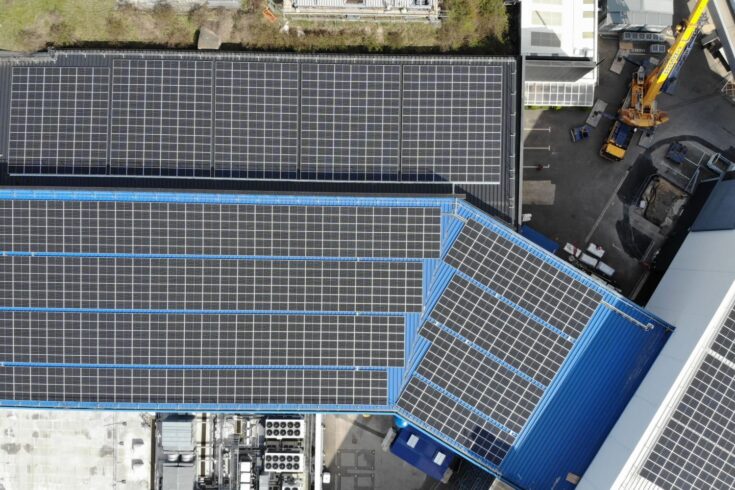One of the UK’s leading science research organisations is undergoing a green transformation, including creating one of the largest solar car ports in the country.
The Science and Technology Facilities Council (STFC) has implemented an action plan to reach net zero carbon emissions by 2040.
This includes installing 12,300 solar panels across two national laboratories in Oxfordshire and the Liverpool City Region.
The sites, Rutherford Appleton Laboratory (RAL) and Daresbury Laboratory, now house three solar car ports in the UK and some of its largest facilities are now covered with solar roof mounts.
In Oxfordshire
At the RAL site, STFC is likely to produce energy that equals a carbon reduction equivalent to 700 tonnes of carbon dioxide emissions per year.
The 8,000 solar panels are due to generate 3,450 megawatt hours (MWh) of energy each year. This is equivalent to enough electricity to power around 1,100 homes for a year.
Without the solar installations, this energy would still be purchased direct from the national grid, which would cost an estimated £515,000 a year.
In the Liverpool City Region
At Daresbury Laboratory, part of the wider Sci-Tech Daresbury campus, more than 4,200 separate solar panels have been installed on car port canopies and on the ground.
The annual energy generation is forecasted to exceed 1,200 MWh per year, the equivalent of enough energy to power around 380 UK homes for a year. This will help reduce carbon emissions by about 280 tonnes of carbon dioxide emissions per year.
If this amount of energy was purchased through the national grid, it could cost £190,000 a year.
As part of the journey to sustainable science, both RAL and Daresbury have also installed more electric car charging ports.
Sustainable future
STFC Executive Chair Professor Mark Thomson said:
STFC strives to be a leader in energy solutions in both the research and innovation it funds, and its own practices.
We are committed to securing an environmentally sustainable future and we want to be at the forefront of critical change.
Our facilities are unique and our infrastructure is complex.
To utilise our impressive experiments and facilities to achieve world-leading science, the energy requirements are very large.
We have had to seek out novel but attainable solutions to make real and lasting progress towards net zero.
Decarbonising science
The combined result of STFC’s projects to install solar panels has achieved a total carbon reduction of 1,080 tonnes, equivalent to annual carbon emissions for around 1,200 domestic UK homes.
STFC secured funding of around £6 million through the Public Sector Decarbonisation Scheme to part fund this work, which is vital in the drive towards its ambitious sustainability.
Jo Colwell, STFC Head of Environmental Sustainability, said:
In the bid for net zero, it is clear that time is of the essence to make substantial changes.
With the support of STFC laboratory colleagues and key partners this investment of resource has enabled us to make substantial progress in reducing our carbon emissions.
With each step towards decarbonising our estate, we are securing an environmentally sustainable future to continue our world-class contributions to outstanding science.
Further information
Solar panels have been installed at the ISIS Neutron and Muon Source and the Research Complex at Harwell (RCaH), both at RAL.
About RCaH
For the past 18 months, RCaH has been considering the impact of our carbon footprint.
This is due to the increasing demand for power that we require to support and nurture world-class research and innovation.
We have been working together with our colleagues across STFC to improve the efficiency of our systems to have a positive impact on the environment.
The new photovoltaic (PV) solar panel system will provide energy, which will be used for the domestic hot water and heating systems of our building.
It is funded by STFC as part of the Estates Strategy 2022 to 2025 commitment towards sustainability and the green economy.
This system will significantly contribute towards reducing our carbon footprint and enable our interdisciplinary research to be conducted as sustainably and efficiently as possible.
Associate Director, John Hand, said:
As a centre of research excellence, we are keen for the RCaH to contribute as much as we can towards a sustainable future.
This installation of solar panels will reduce our carbon footprint and reduce our electricity overhead.
This is an important step towards ensuring a clean and green future for scientific research.
About ISIS
A bright future for ISIS
Close to 6,000 solar panels have been installed on ISIS buildings, generating over 2.4 million kilowatt hours of energy each year and cutting carbon emissions by over 550 tonnes.
The sustainability journey at ISIS continues with more of the facility’s buildings being considered for PV panel installations.
ISIS is also looking at ways of reducing energy and water consumption.
Working with the RAL estates team, ISIS is expanding its remote monitoring systems, developing energy and resource usage dashboards.
This allows for more accurate data collection and a better understanding of energy and water usage at ISIS, helping to identify where inefficiencies exist and reductions can be made.

